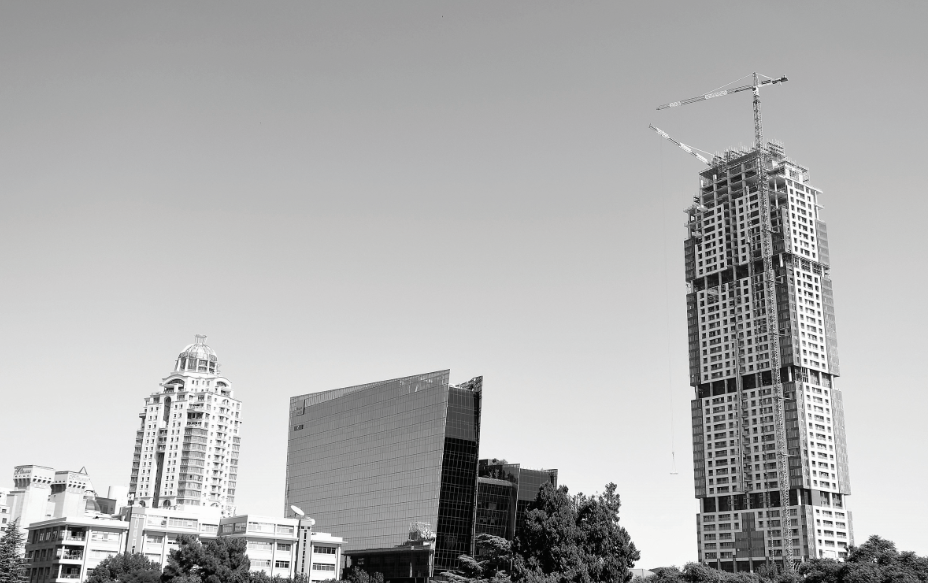South Africa is on its way to another record with Africa’s tallest building.
A new superstructure is making its mark in Sandton in the heart of Africa’s richest square mile.
The $3 billion project is expected to be completed by the end of 2019 and beat Carlton Centre’s reign as the tallest building in Africa since 1973.
The 223-meter, 50-storey Carlton Centre in Johannesburg has for 46 years stood the test of time as a skyscraper dominating the skyline in South Africa and the continent.
The new building coming up in Sandton will be a 55-storey, 234-meter classical Italian eponym paying homage to Leonardo da Vinci, the Italian artist of the Renaissance era.
Loading...
READ MORE | Re-constructing Johannesburg The City Of Opportunity
It adds to the luxurious portfolio of hotels by the Legacy Living property group.
As The Leonardo rising from the bedrock and gradually etches its presence on the skyline, Gijs Foden, Director of Retail Management in Legacy Living, says it is a beacon that represents economic growth far beyond the surface.
“From a development perspective, everyone knows about the crisis in construction. There is light at the end of the tunnel, through a tough economy. It is a tough market and we are working our way out of it. We are going up. We are part of the beacon of hope through tough times,” he says.
South Africa has nine out of 20 of the continent’s tallest buildings, amounting to 1,277 meters in total and 5,000 steps up a staircase.
While most of these buildings were erected in the 1900s and early 2000s, records have stayed the same.
Johannesburg’s Ponte City Tower standing as the third tallest building in Africa, coming in after Kenya’s Britam Tower at 200 meters.
The Leonardo was initially set out to be a mixed-use building with 33 floors but has since escalated to dominating the South African skyscraper inventory.
Foden says the development will not only provide investment opportunities for South Africa, but it will celebrate African authenticity.
Set to be completed in the year of Leonardo Da Vinci’s 500th death anniversary, African art will be the center-piece of the tower.
You look out of the window and that is your canvas. Internally, the art in the building is African art.
“We are supporting the African artist, it is what it is. The art defines the building. Keeping the essence of the building and at the same time the warmth and lifestyle will be an attraction, irrespective of the Italian name,” Foden says.
By following due processes in getting the height approved, overtaking Carlton Centre’s record, Foden says: “It [Carlton Centre] is still an icon and no one has been able to beat it. It is different times and it is also different generations. This is our generation which is going to be a timeless building for many years to come. It is an urban flight.”
However, the record by The Leonardo may be short-lived as yet another African skyscraper may overshadow it by the end of 2021.
The Pinnacle, currently being built in Nairobi’s financial hub, is set to be a 70-storey mixed-use development.
According to a yearly study published by The Council on Tall Buildings and Urban Habitat (CTBUH), Beijing’s China Zun 528-meter skyscraper was the tallest building completed in 2018, making it the eighth-tallest building in the world.
The study reports that 16 new buildings entered the 100 tallest lists in 2018; up from 14 in 2017, 76% of these were in Asia.
Co-Arc Director, Francois Pienaar, says the influx of skyscrapers in Africa is a way for property investors and developers to exploit the options of sites.
“Sites can become very valuable. There are a lot of things to do with money – [for] better returns for the investment of the land, and that is why people go up. It takes quite a lot of courage, to go 55 floors.
You need to have a client who is inspired to do it. Especially, with the volatility of Africa,” Pienaar says.
Despite the competition for a piece of the sky, none of the 2019 projected top 30 tallest buildings will supersede the world’s tallest building in Dubai at a towering 829.8 meters with 163 floors above the ground.
The Burj Khalifa has boasted this record since its completion in 2010.
According to Pienaar, the opportunity to build a structure of this magnitude does not come by every day in Africa.
Breaking his 30-storey skyscraping record, Pienaar, who is currently working on The Leonardo, adds: “It takes a lot more when it comes to delivering services and the kinds of aesthetics that take place.
READ MORE | Richest Cities In The World: The Top 10 Cities With The Most Billionaires
“The building has a skin outside which is imported from Spain. It is a new invention from Spain that reduces the heat load on the glass. We have produced a building that is responsible for the climate. We are trying to keep the building energy-efficient,” he says.
As the global economic outlook develops, there is fierce competition for a piece of the sky.
The taller the building, the more money it pulls in.
As the South African economy picks itself up, the lingering shadow of the Leonardo will represent a symbol of growth and a new dawn.
Loading...
